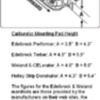Here's the post I just made on the other forum:
> It is a Weiand X-Celerator single plane part #7517 for our Cleveland 4V
> engines. It is supposed to be good for 1500-7000 rpm. Comparing its
> dimensions with the Performer manifold, it appears to only be about a half
> inch taller. It looks like I could fit this manifold under my engine
> screen.
For comparison, here are some height measurements I made of 351C intakes.
The measurements represent the drop from a straight edge laid across the
carb pad to the closest point where the end rail bends inward (each end).
Measurements are in inches:
Holley Strip Dominator 4 5/16 5 3/8
Blue Thunder 4 7/16 5 3/8
Edelbrock F-351 Performer 2V 3 1/2 4 3/8
Ford aluminum 4V 3 1/4 4 3/8
Offenhauser 360 4V 3 1/2 4 1/2
Weiand Xcelerator 2V 4 3/16 5 1/8
Weiand tunnel Ram 9 1/16 9 3/8
base 6 1/4 6 1/4
top 2 3/4 3 1/8
Motorsport A351 (Roush) 6 3/4 6 3/4
A331 (Edelbrock version, not Roush) 4 3/8 5 5/16
I believe the 2V and 4V versions of the Xcelerator are the same height.
The difference between my Xcelerator and a Strip Dominator is a quarter
inch but it sure looks like more than that to the naked eye. I used to
run the Weiand Xcelerator 2V with a 14" diameter drop base air filter case
and 2 1/4" tall K&N element:
http://www.bacomatic.org/gallery/album03/TOF00002It's about as tall a combination that will fit under the a stock Pantera
engine screen. The top just clears the Holley choke tower (probably hurts
high RPM breathing) and the bottom just clears the distributor. Some drop
base air cleaners will rub on the distributor (some distributors are taller
than others) and a Carter AFB has a lower choke tower which might give you
a bit more room to play with.
> Does anyone know anything about this manifold or have experience with it?
See below.
> All I know is what Dan Jones has written. He says that the Xclerator 2V
> and 4V are two very different manifolds. He says that the 2V is a good
> match for the aussie heads and my engine build confirmed that.
> The 4V Xclerator is a reported dog of a manifold and was *not* recommended.
Affirmative. Below, is a summary I made of a couple of 4V intake manifold
tests by Pantera owners. Both of these were on stock displacement but
modified motors. Things could well be different on a big cubic inch
stroker engine. Single plane intakes tend to be more configuration
dependent than dual planes and small differences like dividers or spacers
can make a difference on some combinations.
Dan Jones
Despite the name, the Torker is a big port single plane, as are the
Weiand Xcelerator 4V and Holley Strip Dominator. My experience is the
Torker is weak down low and the Weiand 4V is worse (the 2V version of
the Weiand Xcelerator is often a better intake on 4V heads). The Torker
pulled well at high RPM but around town, the Torker would stumble and
just wasn't as smooth. One of the guys in the Pantera club got pretty
serious about testing intakes and documented similar results. He did a
bunch of road and drag strip intake testing with his Pantera. The engine
consisted of an Erson hydraulic flat tappet cam (232 deg duration @
0.050", 108 LSA, 0.545" lift), Rhoads lifters, 4V quench heads, flat top
pistons, 735 Holley, coatings, C&A rings, MSD ignition, wrapped headers,
and MPG Stinger exaust port stuffers. Intakes tested included an Edelbrock
Torker, Weiand Xcelerator 4V, Offy Port-o-Sonic 4V, Holley Strip Dominator,
along with a couple dual planes. Tim spent a lot of time optimizing the
carb for each intake. The Holley Strip Dominator was 4 tenths quicker in
the 1/4 mile than the Torker and had, by far, the best driveability (smooth
with no flat spots) of the single planes. It rivaled the dual planes down
low, as far as driveability was concerned, and by 3000 RPM was pulling away.
He could never get the Torker to smooth out at lower RPM, despite a lot of
tuning time. Unfortunately, he didn't have access to a Blue Thunder high
rise dual plane for those tests. Note that the single planes tend to be
more sensitive to carb tuning due to the weaker metering signal.
Several other Pantera club members have tested 4V intakes, as well.
One test was a road course test between a Torker, a Weiand Xcelerator 4V,
and an Edelbrock Performer 4V. In a Pantera (3100 lbs, 4.22:1 final drive,
5 speed) with open chamber 4V heads, domed TRW pistons, 230-something cam,
the Performer was faster around the course because the Torker was so dead
below 4000 RPM. The Weiand 4V was worse dead. I offered up my spare
Strip Dominator but it didn't make it in time to be included in the test.


